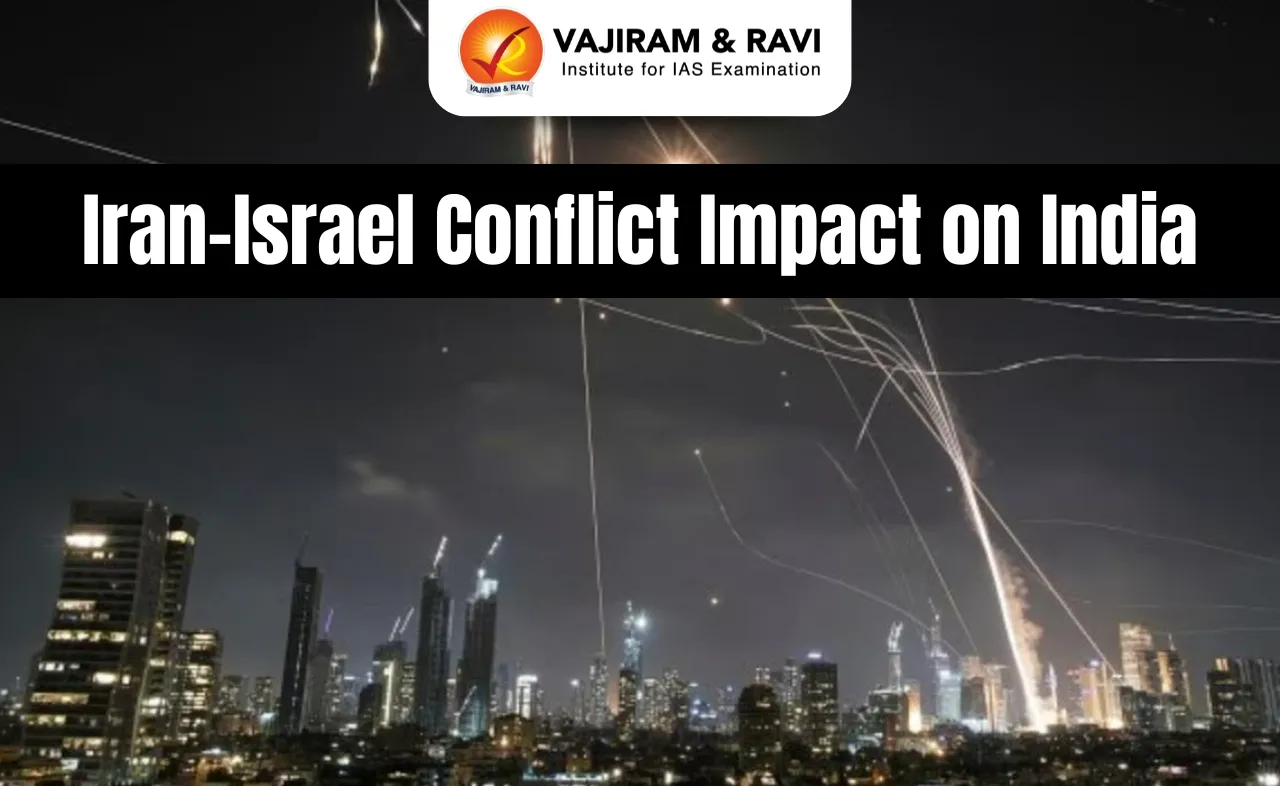Iran-Israel Conflict Impact on India Latest News
- Just as global trade was stabilizing with shipping returning to the Red Sea, the Iran-Israel conflict has reignited fears of oil price surges and trade disruptions.
- The Sensex dropped 573 points amid global market jitters. Experts caution that Iran could block the Strait of Hormuz — a vital route for 20–25% of global oil and key LNG exports from Qatar and the UAE, both crucial to India’s energy needs.
Impact of Iran-Israel Crisis on Indian Economy
- The escalating Israel-Iran conflict adds another layer of uncertainty, potentially affecting India’s economic outlook in the coming months.
Growth and Inflation at Risk
- The escalating Iran-Israel conflict may create macroeconomic challenges for India, particularly due to its heavy reliance on oil imports.
- A $10/bbl increase could lower India’s real GDP growth by 0.3 percentage points and raise consumer inflation by 0.4 points.
- This threatens to reverse India’s recent inflation relief — retail inflation had eased to a 75-month low of 2.82% in May 2025, prompting a 50 basis point repo rate cut by the RBI.
- As oil prices climb, Indian refiners require more dollars to purchase crude, increasing dollar demand, weakening the rupee, and inflating import costs — creating a feedback loop that worsens India’s current account deficit.
Energy Supply Disruption Concerns Grow
- Although energy infrastructure has not yet been directly targeted, risks remain high.
- Iran reported no immediate damage to its refineries, which have a capacity of 2.8 million barrels/day.
- Still, its crude exports may drop below 1.5 million b/d this month, as per S&P Global, adding further uncertainty to global energy markets.
Broader Energy Price Spike Beyond Crude Oil
- The ongoing Middle East conflict has triggered a surge not only in crude oil prices but also in other critical energy imports for India — including LPG, natural gas, petrochemicals, and fertilisers.
- Any disruption could significantly impact India’s rural economy and food inflation due to increased fertiliser costs.
Rural and Agricultural Impact
- Higher fertiliser and LPG prices threaten to burden rural households and reduce farm productivity.
- This could reverse recent gains in food price stability and drive overall inflation upward.
Manufacturing and Industrial Sectors Face Margin Pressures
- Key sectors like aviation, chemicals, paints, tyres, cement, and logistics — all heavily reliant on petroleum-based inputs — are likely to see reduced profit margins due to rising raw material costs.
- Crisil Ratings warns that the impact may differ across sectors depending on their oil dependency.
Sectoral Divide: Winners and Losers
- While upstream oil companies may benefit from higher crude prices, downstream refiners could see their margins squeezed.
- Industries indirectly linked to crude oil — including packaging, plastic products, paints, and specialty chemicals — may pass on the cost to consumers or absorb it, affecting demand or profits respectively.
Rising Costs for MSMEs and Consumers
- If tensions escalate, transport fares and logistics costs may rise, hitting grocery supply chains and increasing costs for MSMEs.
- These businesses may struggle with higher input costs and stagnant demand, leading to tighter margins.
Gold Prices Soar Amid Uncertainty
- Gold futures in India crossed ₹1 lakh per 10 grams, driven by a weak rupee and investor flight to safe assets.
- Retail jewellery demand remains subdued due to high prices, though investment demand is expected to stay strong.
Red Sea Relief Short-Lived as Conflict Escalates
- In May, exporters were optimistic as conditions in the Red Sea improved and normal shipping resumed.
- However, with that confrontation now a reality, traders’ fears have materialised.
- For India — which imports over 80% of its crude — this poses significant macroeconomic risks.
Freight Rates and Insurance Costs Set to Surge
- With vessels likely reverting to the longer Cape of Good Hope route, shipping costs are expected to stay high.
- The detour adds 10–14 days per voyage, straining vessel availability and driving up freight rates and insurance premiums.
LNG Shipping Severely Impacted
- LNG flows through the Suez Canal plummeted from 34.94 million tonnes in 2022 to just 4.15 million tonnes in 2024.
- Meanwhile, LNG volumes via the Cape route surged over five-fold — from 11.76 million tonnes in 2022 to 59.37 million tonnes in 2024.
- This shift underscores the growing logistical burden and potential energy supply risks for countries like India.
Last updated on December, 2025
→ Check out the latest UPSC Syllabus 2026 here.
→ Join Vajiram & Ravi’s Interview Guidance Programme for expert help to crack your final UPSC stage.
→ UPSC Mains Result 2025 is now out.
→ UPSC Notification 2026 is scheduled to be released on January 14, 2026.
→ UPSC Calendar 2026 is released on 15th May, 2025.
→ The UPSC Vacancy 2025 were released 1129, out of which 979 were for UPSC CSE and remaining 150 are for UPSC IFoS.
→ UPSC Prelims 2026 will be conducted on 24th May, 2026 & UPSC Mains 2026 will be conducted on 21st August 2026.
→ The UPSC Selection Process is of 3 stages-Prelims, Mains and Interview.
→ UPSC Result 2024 is released with latest UPSC Marksheet 2024. Check Now!
→ UPSC Prelims Result 2025 is out now for the CSE held on 25 May 2025.
→ UPSC Toppers List 2024 is released now. Shakti Dubey is UPSC AIR 1 2024 Topper.
→ UPSC Prelims Question Paper 2025 and Unofficial Prelims Answer Key 2025 are available now.
→ UPSC Mains Question Paper 2025 is out for Essay, GS 1, 2, 3 & GS 4.
→ UPSC Mains Indian Language Question Paper 2025 is now out.
→ UPSC Mains Optional Question Paper 2025 is now out.
→ Also check Best IAS Coaching in Delhi
Iran-Israel conflict impact on India FAQs
Q1. How does the Iran-Israel conflict affect India's economy?+
Q2. Which sectors in India are most affected?+
Q3. How does the conflict influence inflation in India?+
Q4. What happens to LNG shipments due to the crisis?+
Q5. How is the rupee impacted by rising oil prices?+
Tags: iran-israel conflict mains articles upsc current affairs upsc mains current affairs

















